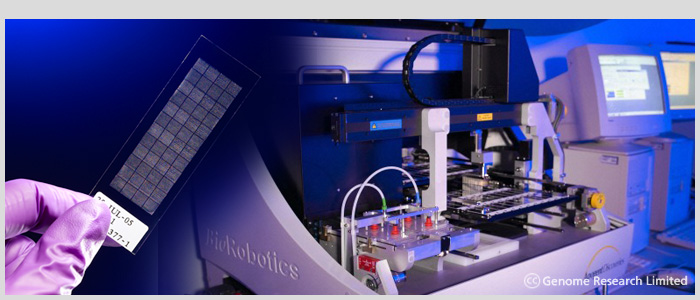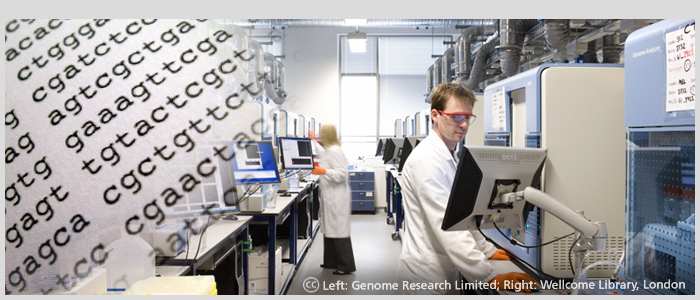Technologies used in DDD
Although many developmental disorders are caused by genetic changes, each individual change is very rare and we usually don’t know where to look for it in the child’s DNA. Instead of having a targeted test for a particular change, we therefore have to look across all of the child’s genome to find out if and where a change occurred which caused the disorder.
We can use a number of different technologies to find genetic alterations. The most basic one is simply to look at the DNA under a microscope. This allows you to see if there are any large changes from what we expect to see. For example, large parts of the genome may have been deleted or new pieces added. If you think of the genome as being a book, these changes are like removing or copying whole chapters of the book. However, most genetic changes are too small to see using a microscope, so new technologies allow us to take an increasingly detailed look at the genome.
Array technology
The first technology we will be using in the DDD study is called an array. This allows us to look at several million sites across an individual’s genome at the same time, far more than can be seen through a microscope. The array is simply a glass slide covered in millions of fragments of DNA from an unaffected individual. The fragments of DNA are all tagged with a coloured dye. DNA from a patient, labelled with a different coloured dye, is washed over the slide and it sticks in certain places. A very high resolution photograph of the slide is then taken so that we can see the colour at each position on the array. The resulting colour ratio tells us whether the patient has the same number of copies of pieces of their DNA as the unaffected person, or more or less. If you think of the genome as being a recipe book, with this technology, we are able to see if whole sentences or paragraphs have been deleted or copied inside the book.

DNA sequencing technology
The second technology we will be using in the DDD study is called sequencing. This involves reading the exact order of letters – As, Cs, Gs and Ts – along a piece of DNA. This is the most detailed genetic test possible. It allows us to read the entire genome ‘recipe book’ from start to end, or to dip in and out and read selected chapters of particular importance. Using sequencing, we are able to detect extra or missing words and spelling mistakes. This technology means that we should be able to find any changes to the DNA that might have caused the child’s developmental disorder. However, interpreting this information is very complicated as there is no appropriate reference to turn to, like a dictionary. Every individual has a unique DNA sequence and there are lots of tiny genetic differences between all of us, some common and some rare. This makes finding the genetic differences which cause a particular developmental disorder much more challenging.

In DDD, we have concentrated on performing exome sequencing, a technique used to sequence just selected regions of DNA which are of particular importance (the protein coding regions) within a genome. The protein-coding regions, or exome, of an individual comprises a very small fraction of the total DNA (less than 2%), but is thought to harbour most of the DNA changes that have a large effect on disease. These changes either alter the protein produced or decrease its amount. Thus, exome sequencing provides an efficient way of detecting genomic changes underlying developmental disorders. The role of the remaining >98% of DNA is still largely unknown, though some of it is involved in determining when cells actually make particular proteins by turning genes ‘on’ or ‘off’. Although there are DNA changes in this non-coding DNA that are important in disease, currently they are much harder to interpret than changes in the coding regions. As well as analysing and re-analysing all the exome sequencing data we have at DDD, we are also investigating using whole genome sequencing to look for mutations in DDD patients who still remain undiagnosed after exome sequencing.